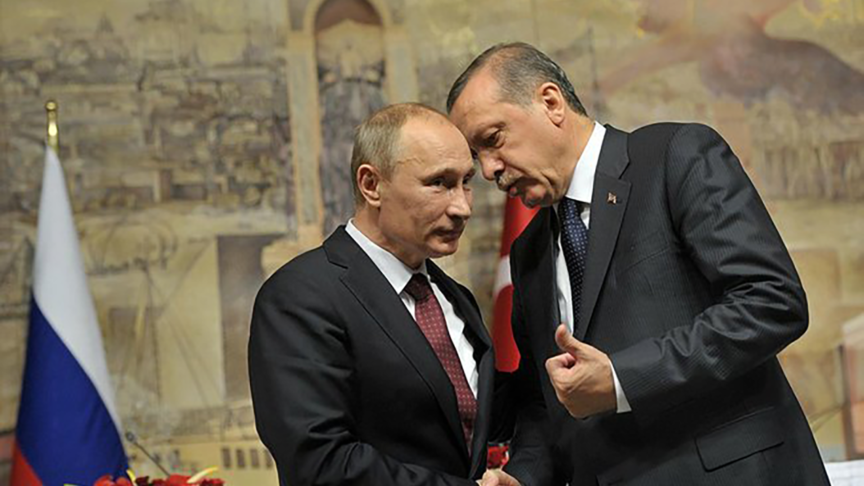Rojava: Turkey Ups the Ante Ahead of Astana
By Lazghine Ya'qoube
On Monday (June 12), people in Rojava were astounded by a US Central Command press release revealing 22 US military personnel were injured in a helicopter “mishap” in southern Hasaka, part of the de facto Autonomous Administration of North and East Syria (AANES)- also known as Rojava.
With the incident repressed for 24 hours, and information remain sketchy, or rather undisclosed. Yet, many have cast doubts over the idea of a “technical default”, though the hypothesis of hostile conduct was utterly dismissed.
The chopper “mishap” made headlines across the world. Yet, that was a precursor to what would follow next.
Further north, the Turkish air force embarked on an abrupt and deadly aerial campaign involving drone strikes across the border in Rojava extending from Aleppo in the north up to eastern Qamishli in the far- east.
The drama was set in motion when Turkey’s state- run media claimed that 41 fighters of Peoples’ Protection Units (YPG) were “neutralized” in the two localities of Manbij and Tal Rifat. Later, that number would rise to 53.
Turkey claimed strikes were in retaliation for alleged attacks against a Turkish base in Jibrine (Aleppo) and a police center in Kilis on Turkish soil.
The term “neutralize” is employed by Turkish military officials and media to imply that adversaries, notably the Kurds, in question are either killed, captured or surrendered.
Refuting claims, the Media Office of the Syrian Democratic Forces (SDF) admitted that four of their fighters were killed in Manbij. However, it denied, categorically, any presence by their units in Tal Rifat.
In May 2022, Tal Rifat, in north Aleppo, and Manbij, in the far- east, became potential target(s) of an imminent Turkish ground invasion announced by the Turkish President Recep Tayyip Erdogan. The Russian President, Vladimir Putin, in a last- minute effort, dissuaded his Turkish counterpart from mounting his Syrian adventure.
Ever since, Turkey has employed its drone technology against the Kurds of Rojava. Late in November 2022, a large-scale aerial bombardment was initiated persistently destroying infrastructure and vital facilities. Besides military personnel, a number of civilians perished in the onslaught which brought all aspects of life to a halt.
Regrettably, the Kurds do not have techniques that could either counter or deactivate Turkey’s highly advanced unmanned combat aerial vehicles.
Prior, on Sunday, YPG admitted that three of their fighters were killed and two others were injured in a similar Turkish act in the al-Ahdath locality (in reference to the Juvenile Detention Center) close to Afrin in north Aleppo.
Monday was a hectic day; a Russian soldier was killed and four others were injured when their vehicle was hit/attacked on the road linking the village of Harbil with that of Um al-Hosh between Tal Rifat and the city of Aleppo. The issue of who stands behind the act remains debatable.
While the UK based- war monitor the Syrian Observatory for Human Rights (SOHR), and Kurdish affiliated media affirmed it was a Turkish shelling that targeted the Russian convoy, other sources speculated the incident was caused by a road bomb that had been planted earlier by the pro-Turkey Syrian National Army (SNA), whose factions harbor grudges against Russian forces.
Consequentially, in south Kobane, four civilians were reported injured and a Kurdish military commander was reported killed close to the strategic Qara Qozakh Bridge spanning River Euphrates.
On Wednesday, four Kurdish military personnel were reported killed by a drone strike close to the village of Shorik in eastern Qamishli. A number of civilians were also injured in the double-strike.
Relatedly, six fighters of the Manbij Military Council- a force affiliated with the SDF- were also killed and two others seriously injured. Five of the six fighters rushed originally to rescue two civilians who had incurred injuries in a Turkish bombardment while reportedly working on their farm in the village of Dandaniye.
Five Syrian regime soldiers were also killed and six others were reported injured in the village of Mayase in Afrin’s Sherawa district making June 14th one of the deadliest with 15 military and one civilian all by armed drones. Later, a commissioned Syrian officer would succumb to his wounds incurred in a previous shelling.
Equally, the sequel to violence resumed on Friday when Tal Rifat’s Hospital was hit allegedly by Turkish bombardment injuring four persons, including medical staff. Two injuries were reported to be very serious.
Since February 6th, the date marking the disastrous earthquake that hit south Turkey and north Syria simultaneously, there had been a kind of relative interregnum or repose in Turkish attacks against northeast Syria. But why now again?
The recent aerial bombardment is the first since Erdogan was re-elected for a third term as president in a run-off held on May 28. This has consolidated Erdogan’s position beyond the borders.
Diplomatically, on Wednesday, Russian’s Deputy Foreign Minister, and Putin’s Special Envoy for the Middle East and Africa, Mikhail Bogdanov, told reporters the draft roadmap for normalizing relations between Ankara and Damascus, proposed by Moscow, was ready. The next step, according to Bogdanov, was to discuss the draft with partners to streamline the efforts in helping both countries resume diplomatic missions.
Bogdanov’s announcement precedes a four-way meeting between Deputy Foreign Minister Affairs of Syria, Turkey, Russia, and Iran slated to meet in the capital of Kazakhstan, Astana, on June 21, with reconciling Damascus and Ankara the primary objective. Bogdanov said a large Russian delegation is going to Astana.
Historically, there seems always a nexus between realities on the ground (military) and what takes place behind curtains (diplomacy). Although mutually correlated, the former gives substance to the latter. This is fundamentally true of Rojava.
On May 10, the foreign ministers of the four countries met in Moscow in a landmark thaw ending a decade- long enmity. Later, on May 23rd, then Turkey’s Defense Minister, Hulusi Akar, said Russia, Turkey, Iran, and Syria had agreed to establish a four- way joint center on Syrian soil to monitor the incidents in the field.
Far and foremost targeting Kurds, the “joint center” is reminiscent of and could be an appealing alternative to the all- security Adana Agreement signed between Damascus and Ankara in 1998.
The Adana Agreement was a breakthrough in the sense it ensued unprecedented improvement in relations between the two countries. Thanks to the mediation of the then Egyptian President Husni Mubarak. Today, Putin plays a part. While already assuming the role of guarantor in the Astana Format, Putin, sometimes a coercive mediator, has set his sight on a Syrian-Turkish settlement.
The step- by- step approach, and the tit- for- tat strategy, seem to yield results to Putin’s mission in helping “hostile” friends bridge the gap and build confidence between Erdogan and the newly emboldened Syrian President Bashar Assad.
Moscow believes a modified version of the Adana Agreement could ameliorate, though partially, Ankara’s security “concerns” beneath its southern borders in Syria. The idea was first floated by Foreign Affairs Minister Sergei Lavrov in a Sochi meeting in 2019.
The agreement spells out that Turkey could mount cross- border operations (within 5km depth) against members of the Kurdistan Workers’ Party (PKK). Turkey has always considered YPG/SDF an extension to PKK. Not unexpectedly, Syrian regime officials have repeatedly described YPG/SDF as “traitors” and “collaborators” with the US, a signal appealing to Ankara.
Turkey’s recent escalation denotes that a security coordination could be part of the proposed roadmap, a connotation that is echoed openly in Rojava.
In an interview with the Qamishli- based Hawar News Agency (ANHA), an SDF official stated that Turkish bombardment against Rojava was apparently in tacit agreement with Russia and the Syrian regime.
Though indirectly, Zaydan al-Asi, co-chair of Rojava’s Defense Affairs Bureau, went further by lashing out at the U.S. led Global Coalition to Defeat ISIS, SDF’s main ally in the fight against ISIS, for being inactive in bridling Turkey’s drone war against northeast Syria.
Seemingly, this prompted the AANES to ask- in a relevant statement- the Syrian regime, Russia, and notably the Global Coalition to clarify their positions towards the recent escalation by Turkey.
The Kurds have ruled the area since 2012 following hard- fought battles with ISIS. Today, the area has become a bone of contention between state and non- state actors, with each embracing a different ideology.
In a sense, the Harbil- Um al-Hosh occurrence highlights categorically the complex, multi-dimensional and multi-faceted Syrian crisis. Rojava has become a convergence and a battleground for many actors.
Iranian backed militias have been notably on the rise specifically in east Qamishli. They are a kind of underground force maintain basically a considerable presence in Deir Ezzor particularly in al-Mayadin, in the southeast.
Pro-Turkey factions of the Syrian National Army (SNA) who occupy the Sere Kaniye (Ras al-Ain)- Tal Abyad salient, command the strategically important Aleppo-Hasaka highway, commonly referred to M4. They have ever since 2019 coveted Tal Tamr in the east and Kobane in the west. Both areas remain subject to their constant shelling.
Syrian regime forces have maintained symbolic yet strategic security presence in certain pockets in Hasaka and Qamishli. Following a Putin- Erdogan understanding in the Russian resort city of Sochi on October 22, 2019, Syrian regime forces were deployed to the border with Turkey after SDF withdrew from the area they had controlled since mid- 2012. Turkey maintains the clause relevant to SDF withdrawal has not been met. This gives Turkey the right to behave independently, it claims.
The United States with nearly 900 boots on the ground seem more reclusive with concentrating mainly on the Syrian-Iraqi border area. Differently, Russia maintains larger presence in Syria and slowly yet steadily has expanded to areas not allowed to reach before 2019.
Grasping the moment, the US, not idle though, has announced it was sending F-22 planes to the region to counter the increased “unsafe and unprofessional behavior” by Russian aircrafts, and more importantly to improve “security and stability” in the turbulent region. This strong response is an indication of how Russia’s role is mounting.
Late on Thursday, an armed group- purportedly affiliated with ISIS, engaged in skirmishes with SDF in the district of Busayra in Deir Ezzor. Although no casualties were reported, yet the attack is an indication of how ISIS still pose threats to the region. Not only ISIS, pro- Iran militia groups (more supportive of Russia than the US) are also active in the area.
The expanse between Hasaka and Deir Ezzor, nonetheless, remains a hotbed for ISIS’ sleeper cells who have ever since the territorial dismantlement of the group’s self- proclaimed caliphate in Baghouz in March 2019, resorted to hit-and-ran tactics against the U.S. soldiers and their local partners, the SDF.
After nearly a ten-year experiment of self- governance, and as the region undergoes a geopolitical change, the Kurds of Syria ask for guarantees that their rights be secured legally. Observers, however, have established a conviction that the Syrian dilemma is still a long way to be political solution proper.
In 2012, the Kurds gained ground as relations between Damascus and Ankara deteriorated beyond repair. Today, things look different; with the return of Assad to the Arab fold, and the re-election of Erdogan for another five-year term in office, Damascus and Ankara have embarked on a process to mend old fences. It is a thorny process, part of which could entail painful consequences for the Kurds of Rojava.
Much worse, the appointment of Hakan Fidan, former Chief of National Intelligence Services (MIT) to the post of Foreign Affairs Minister, is central to accelerating the process. The man who has profound knowledge of Syria’s protracted crisis, could be the kingmaker in the long- sought and much-awaited rapprochement. Ironically, Fidan’s Kurdish origin could be disruptive to Rojava; a cause that needs recognition not negligence.




Comments are closed.